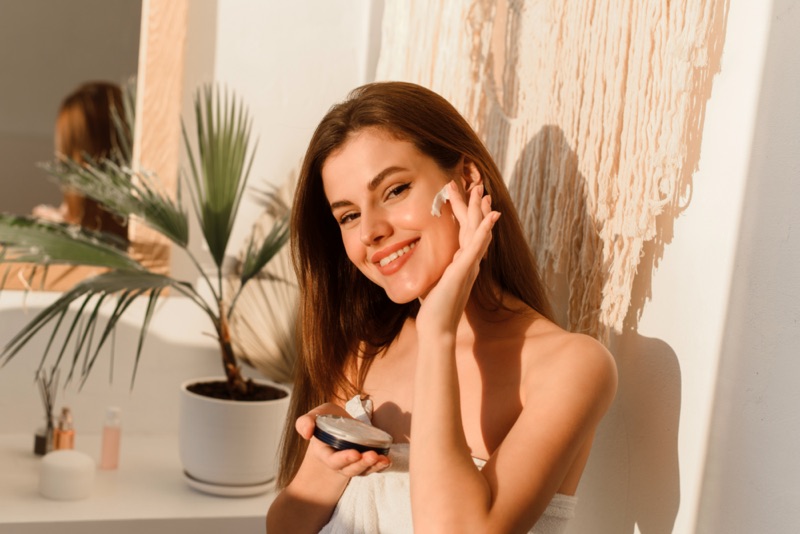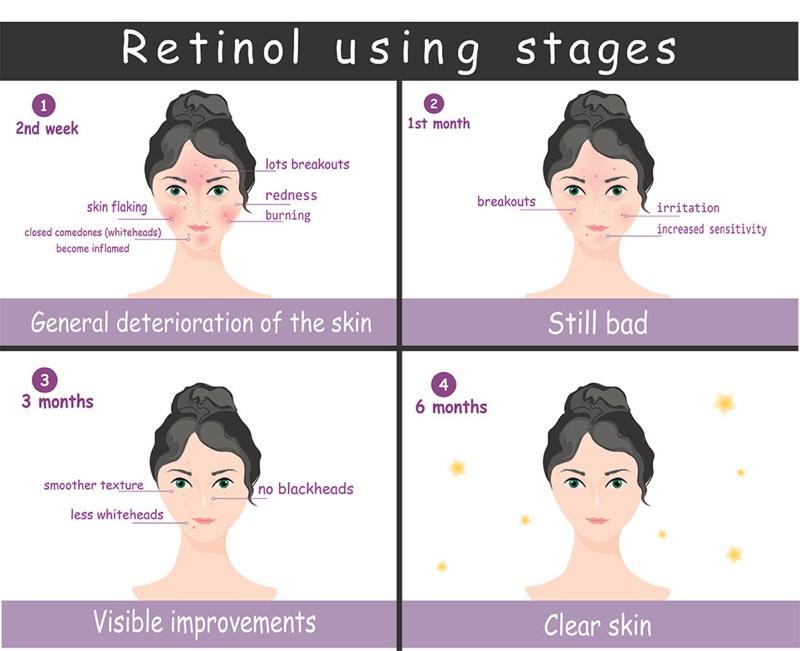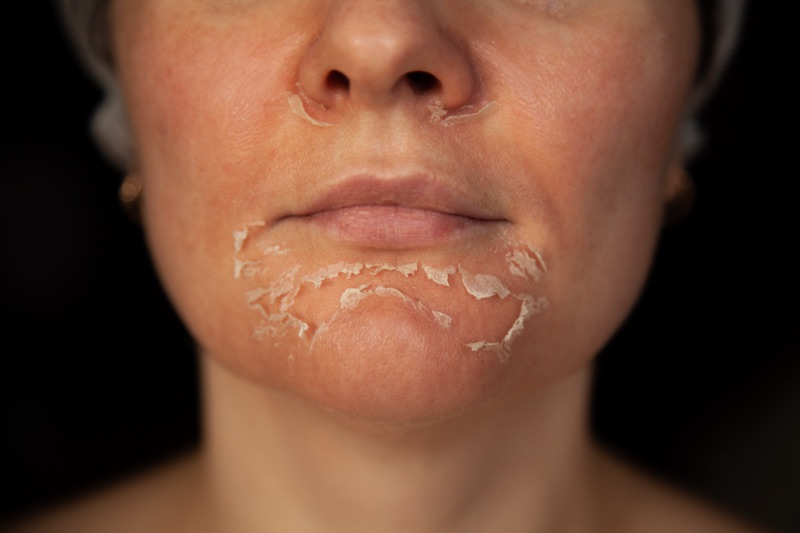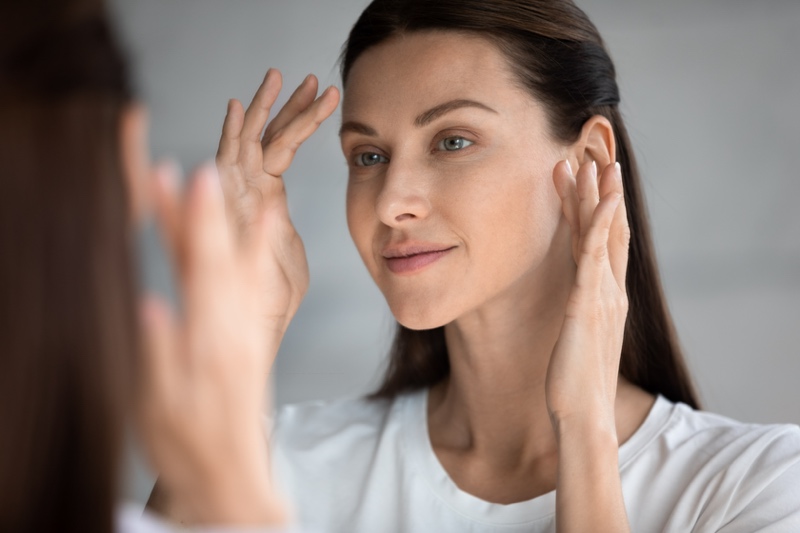Retinol is a derivative of vitamin A and an ingredient to help us resolve skin concerns like premature aging, acne condition, and hyperpigmentation.
Retinol is often confused with Retinoids (also a derivative of vitamin A) but in easy language, Retinol is comparatively milder than Retinoids, hence it is easily available over the counter, while Retinoids need a prescription. Because Retinol is mild, it also works slower compared to Retinoids yet effective in solving most of our skin troubles.

So, Is Retinol used before or after moisturizer?
- It’s honestly about preference. I mean you can apply Retinol first, followed by moisturizer or you can follow the ‘sandwich method’ of layering moisturizer – Retinol -moisturizer.
- If you have a sensitive skin type, are a beginner, or just want to be extra cautious while using retinol, the ‘M-R-M’ method will be safer for you.
- Moisturizer will help soothe any potential dryness first and create an extra layer between your skin and Retinol for extra safety including all the retinol benefits.
- If you’re a Retinol veteran, wash your face, pat it dry, and go ahead with applying a pea-sized amount of retinol followed by moisturizer.
How to apply Retinol safely in your skincare routine?
- Wash your face.
- Pat the skin dry
- Layer a non-comedogenic Moisturizer first, and let it absorb completely into the skin.
- Protect your eye area with a thin layer of Vaseline around for safety.
- Now, apply a pea size amount of Retinol on the entire face and neck.
- Massage it in light circular strokes.
- Finish off with another layer of moisturizer.
What are the benefits of Retinol for our skin that people rave about so much?
See for yourself
- It has evidently shown positive results in boosting collagen and elastin production in the skin by increasing the skin cell turnover rate to double speed.
- Treating acne and acne scars.
- Retinol works on the skin concerns like fine lines and wrinkles.
- Takes care of dark spots and premature aging signs.
- Works great for hyperpigmentation and discoloration skin conditions.
How does Retinol actually work on your skin? (Pretty Interesting part!)
- When we start aging, our cells don’t regenerate as quickly as they used to, when we were young, sadly.
- Now, Retinol directly affects our gene expression, regulating all our age-related issues by eliminating dead skin cells and allowing fresh, young skin cells to come up to the surface.
- Unlike other ingredients in the market, it goes deep into the layers of the skin and exfoliates it from within. It clears up acne by cleaning up the pores and eliminating bacterial growth. Amazing right?

Are there any side effects of Retinol?
Nothing this amazing comes with a few side effects but that mostly happens when you don’t use it carefully
Side effects of Retinol:
- Retinol increases the photosensitivity of the skin. This means your skin becomes highly sensitive to the UV radiation of the sun and can give you harsh sunburn.
- When using Retinol for the first time, there can be an adjustment period to build your Retinol tolerance and you might face side effects like scaliness, redness, dry skin, tightness, and even mild burns.
- If you are not able to handle the allergic reactions by yourself or if they look very painful, please see a board-certified dermatologist.
How to incorporate Retinol safely into your skincare routine? (Important note)

- Start with the lowest concentration of Retinol like 0.1% / 0.25% and gradually increase to a maximum of 1%.
- Never apply Retinol on damp skin
- Don’t apply Retinol too close around your eyes and mouth.
- Just a pea-sized amount is enough. Too much quantity does more harm than good.
- Never forget to use it on the neck as well. The skin of the neck is very thin and starts aging fast.
- Don’t forget to apply a moisturizer with a few drops of Hyaluronic acid mixed with it to combat dry skin.
- You can also add Borage seed oil to your skincare routine as it has shown some excellent results in combating dryness and redness. The oil instantly nourishes the skin from within.
- If you’re a newbie, start slow by using it twice a week & then gradually increase it to every other night.
- Avoid using other products like AHA’s/ BHA/s in your skincare routine when you’re beginning your retinol journey. This can minimize the chances of excess flaking, over-exfoliation, and burns.
- Always wear sunscreen in the daytime to avoid photosensitivity.
- Always GO SLOW with the amount and usage to avoid flakiness, irritation, or any burns.
Extra tip (Only for experienced Retinol users)
In order to experience the deepest level of skin penetration, you might want to use it after you exfoliate, so your skin is maximum receptive to it.
Also, People with Ivory skin should start using Retinol in their mid-20s as their skin is more prone to early signs of aging compared to dark skin.
Who should not use Retinol?
- Dry or Sensitive skin types, like people with Rosacea or Eczema condition, should avoid Retinol. It can make the skin very dry for you.
- If you’re trying for pregnancy, are pregnant, breastfeeding. Do not use retinoids of any kind.
Overall is Retinol safe for an everyday skincare routine?
Yes. It’s a superb scientific dig for acne and anti-aging signs. Just be sure to follow all the rules when you apply retinol.
How long does Retinol take to work?
Retinol takes between 4 Weeks – 12 Weeks, of consistent usage to start showing the desired results.
Now, if you get a Retinol burn or Retinol purge, you should know how to tackle it without panicking! Skin comes back to normal, but you can help it heal faster. See how
Retinol Burn Care Tips!

- Don’t use harsh cleansers or moisturizers with fragrance, alcohol, or sulfates.
- Stay away from makeup for a while.
- Use Thermal spring water to calm the skin (Try from La Roche Posay).
- Take cold showers or ice (Wrapped in a thin cloth) on your face. Avoid hot showers at all. It will irritate the hell out of the skin.
- Don’t use any exfoliating fancy gadgets to wash your face, simply hands.
- Add humectants to your skincare routine like a few drops of Glycerin and Hyaluronic acid.
- Give a lot of moisture and hydration to the skin for it to feel better. Use moisturizers loaded with Ceramides (Helps with skin barrier), Oatmeal, or Hyaluronic acid.
- After Moisturizer, seal the skin with an occlusive like Vaseline. It locks in all the goodies and heals the skin faster.
- Stop using any other exfoliants, acids, AHAs, BHAs, peroxides, vitamin C, or salicylic acid until you are completely healed.
- Cica Balms and Aloe vera are great soothing and calming agents for the skin.
- Product suggestion- Try Avene– Cicalfate + restorative protective cream.
- DO NOT forget to apply sunscreen before stepping outside. Remember you already have vulnerable and sensitive skin right now. UV rays will make it worse.
Does the Packaging of Retinol Products matter?
Yes! Retinol Products are very unstable and sensitive in nature; hence Retinol packaging is literally everything, which surprisingly very few people know of. Air Exposure means Retinol death. So read on.
There are 4 types of packaging in the market:
- Tubes (Best)
- Pump bottles (Better)
- Serum bottles (Okay)
- Jars (NAH)
Tubes are undoubtedly the best and the safest form to use Retinol products. Retinol cream, when stored in the tubes, has a much longer shelf life than any other packaging. Beware of the Jars with those big lids. They don’t make sense at all.
Does the storage condition of Retinol matter?
Retinol is not a stable ingredient in nature and perhaps it likes staying in cool, dark places for the longevity of the shelf life. Retinol should stay completely away from Sunlight, to maintain its shelf life. Hence, your bathroom cabinets work just fine.
Brand Recommendations for Retinol
Here are some of the best products containing Retinol:
1. Differin Gel – Adapalene is an evidence-based ingredient that is also FDA Approved to treat acne, and repair aging signs of the skin like fine lines and wrinkles with long-term use. Price: 18 USD
2. La Roche Posay Adapalene – Same ingredient- Adapalene with different brand names. Adapalene is a mild form of Retinol compared to Tretinoin or other forms of Vitamin A. Price: 37 USD
3. Avene Retrinal 0.1 intensive – It contains Retinol and Peptides and is one of the soothing retinol formulations which makes it feasible to use even around the eyes. It has some great reviews on curing crows’ feet around the eyes, wrinkles around the mouth, and lines on the neck. Price: 74 USD
4. Cereve Resurfacing Retinol– It’s a combination of Retinol, Niacinamide, Licorice root, and Ceramides. This nongreasy gel textured formula is even suited for people with skin conditions like Rosacea. It’s a mild retinol formula compared to other retinol products. Licorice root brightens the skin, niacinamide helps calm the redness of the skin and ceramides strengthen the skin barrier which makes it a brilliant product for everyday use. Price: 23 USD
5. Neutrogena rapid wrinkle repair regenerating cream– This creamy and rich moisturizer is a wrinkle fighter for your skin. The description on its packaging claims that it starts to reduce the appearance of dark spots, wrinkles, and dullness in just one week of usage. Price: 28 USD
Related Articles
If you loved reading this article, you will probably also enjoy reading:
- Can you use Vitamin C with Retinol?
- Can you use Glycolic Acid with Retinol?
- Can you use Benzoyl Peroxide with Retinol?
- Can you use Azelaic Acid and Retinol Together
- Can you use Retinol And Hyaluronic Acid Together?
- Can you use Niacinamide with Retinol?
- Can you use Salicylic Acid and Retinol Together?
- Porcelain Skin-is it the most beautiful skin?
After reading this article, you’ll know how to handle Retinol burns or purge in your skincare journey now with minimum backfires.
Love~ Beauty Stroll